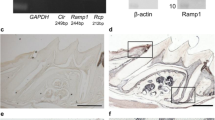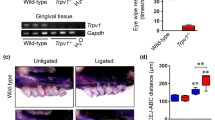Abstract
Pituitary adenylate cyclase-activating peptide (PACAP) is widely distributed throughout the nervous system. PACAP not only acts as a neurotransmitter but also elicits a broad spectrum of biological action via the PACAP-specific receptor, PAC1. However, no studies have investigated PACAP and PAC1 in the periodontal ligament (PDL), so we aimed to perform this investigation in rats after tooth luxation. In the PDL of an intact first molar, there are few osteoclasts and osteoblasts. However, at days 3 and 5 after luxation, large PAC1-positive cells, thought to be osteoclasts because of their expression of the osteoclast marker, tartrate-resistant acid phosphatase, were detected in appreciable numbers. Osteoblast numbers increased dramatically on day 7 after luxation, and PAC1-positive mononuclear small cells were increased at day 14, many of which expressed the osteoblast marker, alkaline phosphatase. PACAP-positive nerve fibers were rarely detected in the PDL of intact first molars, but were increasingly evident at this site on days 5 and 7 after luxation. Double-immunofluorescence analysis demonstrated the relationship between PACAP-positive nerve fibers and PAC1-positive osteoclasts/-blasts in the PDL. At 5 days after luxation, PACAP-positive nerve fibers appeared in close proximity to PAC1-positive osteoclasts. At 7 days after luxation, PACAP-positive nerve fibers appeared in close proximity to PAC1-positive osteoblasts. These results suggest that PACAP may have effects on osteoclasts and osteoblasts in the PDL after tooth luxation and thus regulate bone remodeling after these types of injury.





Similar content being viewed by others
References
Arimura A (1992) Pituitary adenylate cyclase activating polypeptide (PACAP): discovery and current status of research. Regul Pept 37(3):287–303
Armstrong BD, Abad C, Chhith S, Cheung-Lau G, Hajji OE, Nobuta H, Waschek JA (2008) Impaired nerve regeneration and enhanced neuroinflammatory response in mice lacking pituitary adenylyl cyclase activating peptide. Neuroscience 151(1):63–73
Barros I, Muramoto T, Soma K (2007) Effects of occlusal loading on alveolar bone remodeling and changes in the distribution of neuropeptides after tooth replantation in rats. J Med Dent Sci 54(1):49–56
Bjurholm A, Kreicbergs A, Terenius L, Goldstein M, Schultzberg M (1988) Neuropeptide Y-, tyrosine hydroxylase- and vasoactive intestinal polypeptide-immunoreactive nerves in bone and surrounding tissues. J Auton Nerv Syst 25(2–3):119–125
Bjurholm A, Kreicbergs A, Schultzberg M, Lerner UH (1992) Neuroendocrine regulation of cyclic AMP formation in osteoblastic cell lines (UMR-106-01, ROS17/28, MC3T3-E1, and Saos-2) and primary bone cells. J Bone Miner Res 7(9):1011–1019
Botia B, Basille M, Allais A, Raoult E, Falluel-Morel A, Galas L, Jolivel V, Wurtz O, Komuro H, Fournier A, Vaudry H, Burel D, Gonzalez BJ, Vaudry D (2007) Neurotrophic effects of PACAP in the cerebellar cortex. Peptides 28(9):1746–1752
Deguchi T, Takeshita N, Balam TA, Fujiyoshi Y, Takano-Yamamoto T (2003) Galanin-immunoreactive nerve fibers in the periodontal ligament during experimental tooth movement. J Dent Res 82(9):677–681
Delgado M, Garrido E, Martinez C, Leceta J, Gomariz RP (1996) Vasoactive intestinal peptide and pituitary adenylate cyclase-activating polypeptides (PACAP27) and PACAP38) protect CD4+ CD8+ thymocytes from glucocorticoid-induced apoptosis. Blood 87(12):5152–5161
Fahrenkrug J (2001) Gut/brain peptides in the genital tract: VIP and PACAP. Scand J Clin Lab Invest 234:35–39
Gaytan F, Martinez-Fuentes AJ, Garcia-Navarro F, Vaudry H, Aguilar E (1994) Pituitary adenylate cyclase-activating peptide (PACAP) immunolocalization in lymphoid tissues of the rat. Cell Tissue Res 276(2):223–227
Gottschall PE, Tatsuno I, Arimura A (1994) Regulation of interleukin-6 (IL-6) secretion in primary cultured rat astrocytes: synergism of interleukin-1 (IL-1) and pituitary adenylate cyclase activating polypeptide (PACAP). Brain Res 637(1–2):197–203
Harmar T, Lutz E (1994) Multiple receptors for PACAP and VIP. Trends Pharmacol Sci 15(4):97–99
Harmar AJ, Arimura A, Gozes I, Journot L, Laburthe M, Pisegna JR, Rawlings SR, Robberecht P, Said SI, Sreedharan SP, Wank SA, Waschek JA (1998) International union of pharmacology. XVIII. Nomenclature of receptors for vasoactive intestinal peptide and pituitary adenylate cyclase-activating polypeptide. Pharmacol Rev 50(2):265–270
Kato J, Ichikawa H, Wakisaka S, Matsuo S, Sakuda M, Akai M (1990) The distribution of vasoactive intestinal polypeptides and calcitonin gene-related peptide in the periodontal ligament of mouse molar teeth. Arch Oral Biol 35(1):63–66
Kook YA, Lee SK, Son DH, Kim Y, Kang KH, Cho JH, Kim SC, Kim YS, Lee HJ, Lee SK, Kim EC (2009) Effects of substance P on osteoblastic differentiation and heme oxygenase-1 in human periodontal ligament cells. Cell Biol Int 33(3):424–428
Kovacs CS, Chik CL, Li B, Karpinski E, Ho AK (1996) Pituitary adenylate cyclase-activating peptide stimulates cyclic AMP accumulation in UMR 106 osteoblast-like cells. J Endocrinol 149(2):287–295
Lee M, Lelievre V, Zhao P, Torres M, Rodriguez W, Byun JY, Doshi S, Ioffe Y, Gupta G, de los Monteros AE, de Vellis J, Waschek J (2001) Pituitary adenylyl cyclase-activating polypeptide stimulates DNA synthesis but delays maturation of oligodendrocyte progenitors. J Neurosci 21(11):3849–3859
Lerner UH, Persson E (2008) Osteotropic effects by the neuropeptides calcitonin gene-related peptide, substance P and vasoactive intestinal peptide. J Musculoskelet Neuronal Interact 8(2):154–165
Lerner UH, Lundberg P, Ransjo M, Persson P, Hakanson R (1994) Helodermin, helospectin, and PACAP stimulates cyclic AMP formation in intact bone, isolated osteoblasts, and osteoblastic cell lines. Calcif Tissue Int 54(4):284–289
Li J, Kreicbergs A, Bergstrom J, Stark A, Ahmed M (2007) Site-specific CGRP innervation coincides with bone formation during fracture healing and modeling: a study in rat angulated tibia. J Orthop Res 25(9):1204–1212
Lundberg P, Bostrom I, Mukohyama H, Bjurholm A, Smans K, Lerner UH (1999) Neuro-hormonal control of bone metabolism: vasoactive intestinal peptide stimulates ALP activity and mRNA expression in mouse calvarial osteoblasts as well as calcium accumulation in mineralized bone nodules. Regul Pept 85(1):47–58
Lundberg P, Lundgren I, Mukohyama H, Lehenkari PP, Horton MA, Lerner UH (2001) Vasoactive intestinal peptide (VIP)/pituitary adenylate cyclase-activating peptide receptor subtypes in mouse calvarial osteoblasts: presence of VIP-2 receptors and differentiation-induced expression of VIP-1 receptors. Endocrinology 142(1):339–347
Mackie EJ (2003) Osteoblasts: novel roles in orchestration of skeletal architecture. Int J Biochem Cell Biol 35(9):1301–1305
Martinez C, Delgado M, Gomariz RP, Ganea D (1996) Vasoactive intestinal peptide and pituitary adenylate cyclase-activating polypeptide-38 inhibit IL-10 production in murine T lymphocytes. J Immunol 156(11):4128–4136
Martinez C, Delgado M, Pozo D, Leceta J, Calvo JR, Ganea D, Gomariz RP (1998) VIP and PACAP enhance IL-6 release and mRNA levels in resting peritoneal macrophages: in vitro and in vivo studies. J Neuroimmunol 85(2):155–167
Miyashin M, Kato J, Takagi Y (1990) Experimental luxation injuries in immature rat teeth. Endod Dent Traumatol 6(3):121–128
Miyashin M, Kato J, Takagi Y (1991) Tissue reactions after experimental luxation injuries in immature rat teeth. Endod Dent Traumatol 7(1):26–35
Miyata A, Arimura A, Dahl RR, Minamino N, Uehara A, Jiang L, Culler MD, Coy DH (1989) Isolation of a novel 38 residue-hypothalamic polypeptide which stimulates adenylate cyclase in pituitary cells. Biochem Biophys Res Commun 164(1):567–574
Nagata A, Tanaka T, Minezawa A, Poyurovsky M, Mayama T, Suzuki S, Hashimoto N, Yoshida T, Suyama K, Miyata A, Hosokawa H, Nakayama T, Tatsuno I (2009) cAMP activation by PACAP/VIP stimulates IL-6 release and inhibits osteoblastic differentiation through VPAC2 receptor in osteoblastic MC3T3 cells. J Cell Physiol 221(1):75–83
Nagayama T, Seiryu M, Deguchi T, Kano M, Suzuki T, Takano-Yamamoto T, Ichikawa H (2012) Increase of CGRP-containing nerve fibers in the rat periodontal ligament after luxation. Cell Mol Neurobiol 32(3):391–397
Ransjo M, Lie A, Mukohyama H, Lundberg P, Lerner UH (2000) Microisolated mouse osteoclasts express VIP-1 and PACAP receptors. Biochem Biophys Res Commun 274(2):400–404
Reimer M, Moller K, Sundler F, Hannibal J, Fahrenkrug J, Kanje M (1999) Increased expression, axonal transport and release of pituitary adenylate cyclase-activating polypeptide in the cultured rat vagus nerve. Neuroscience 88(1):213–222
Somogyvari-Vigh A, Reglodi D (2004) Pituitary adenylate cyclase activating polypeptide: a potential neuroprotective peptide. Curr Pharm Des 10(23):2861–2889
Strange-Vognsen HH, Arnbjerg J, Hannibal J (1997) Immunocytochemical demonstration of pituitary adenylate cyclase activating polypeptide (PACAP) in the porcine epiphyseal cartilage canals. Neuropeptides 31(2):137–141
Suarez V, Guntinas-Lichius O, Streppel M, Ingorokva S, Grosheva M, Neiss WF, Angelov DN, Klimaschewski L (2006) The axotomy-induced neuropeptides galanin and pituitary adenylate cyclase-activating peptide promote axonal sprouting of primary afferent and cranial motor neurones. Eur J Neurosci 24(6):1555–1564
Suzuki A, Kontoyori J, Oiso Y, Kozawa O (1994) Pituitary adenylate cyclase-activating peptide induces cAMP production independently from vasoactive intestinal polypeptide in osteoblast-like cells. Cell Signal 6(1):11–16
Takei N, Torres E, Yuhara A, Jongsma H, Otto C, Korhonen L, Abiru Y, Skoglosa Y, Schutz G, Hatanaka H, Sofroniew MV, Lindholm D (2000) Pituitary adenylate cyclase-activating polypeptide promotes the survival of basal forebrain cholinergic neurons in vitro and in vivo: comparison with effects of nerve growth factor. Eur J Neurosci 12(7):2273–2280
Tatsuno I, Gottschall PE, Arimura A (1991a) Inhibition of mitogen-stimulated proliferation of murine splenocytes by a novel neuropeptide, pituitary adenylate cyclase activating polypeptide: a comparative study with vasoactive intestinal peptide. Endocrinology 128(2):728–734
Tatsuno I, Somogyvari-Vigh A, Mizuno K, Gottschall PE, Hidaka H, Arimura A (1991b) Neuropeptide regulation of interleukin-6 production from the pituitary: stimulation by pituitary adenylate cyclase activating polypeptide and calcitonin gene-related peptide. Endocrinology 129(4):1797–1804
Teitelbaum SL (2000) Bone resorption by osteoclasts. Science 289(5484):1504–1508
Togari A, Arai M, Mizutani S, Mizutani S, Koshihara Y, Nagatsu T (1997) Expression of mRNAs for neuropeptide receptors and beta-adrenergic receptors in human osteoblasts and human osteogenic sarcoma cells. Neurosci Lett 233(2–3):125–128
Vaudry D, Gonzalez BJ, Basille M, Yon L, Fournier A, Vaudry H (2000) Pituitary adenylate cyclase-activating polypeptide and its receptors: from structure to functions. Pharmacol Rev 52(2):269–324
Waschek JA, Casillas RA, Nguyen TB, DiCicco-Bloom EM, Carpenter EM, Rodriguez WI (1998) Neural tube expression of pituitary adenylate cyclase-activating peptide (PACAP) and receptor: potential role in patterning and neurogenesis. Proc Natl Acad Sci USA 95(16):9602–9607
Winding B, Wiltink A, Foged NT (1997) Pituitary adenylyl cyclase-activating polypeptides and vasoactive intestinal peptide inhibit bone resorption by isolated rabbit osteoclasts. Exp Physiol 82(5):871–886
Acknowledgments
This work was supported by a Grant for Scientific Research from the Ministry of Education, Culture, Sports, Science and Technology, Japan.
Conflict of interest
All authors declare that they have no conflict of interest.
Author information
Authors and Affiliations
Corresponding author
Rights and permissions
About this article
Cite this article
Nonaka, S., Kitaura, H., Kimura, K. et al. Expression of Pituitary Adenylate Cyclase-Activating Peptide (PACAP) and PAC1 in the Periodontal Ligament After Tooth Luxation. Cell Mol Neurobiol 33, 885–892 (2013). https://doi.org/10.1007/s10571-013-9953-4
Received:
Accepted:
Published:
Issue Date:
DOI: https://doi.org/10.1007/s10571-013-9953-4




